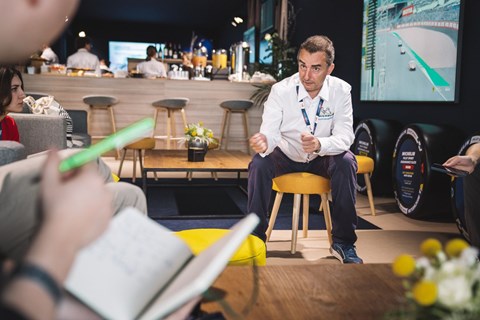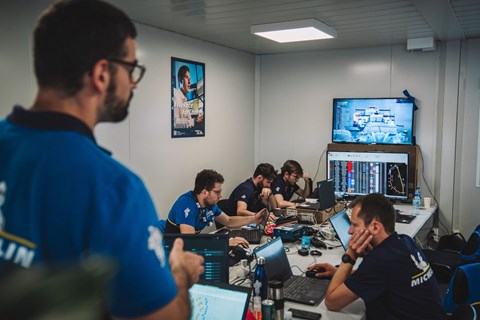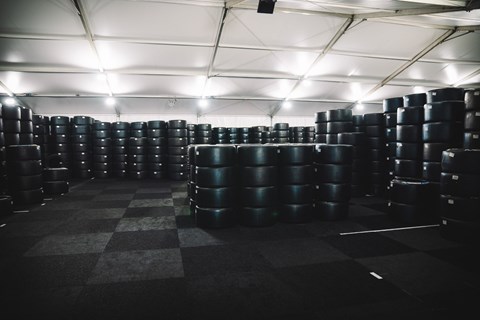► Le Mans 2023 marks 100 years of the race
► Up close with Michelin, the sole tyre supplier to the Hypercar class
► The quest to make endurance racing greener
Le Mans can be a chaotic race that can push every single component of a car to its limits and nothing goes through more punishment than the tyres. Case in point, take a high-performance road tyre and use it at Le Mans and it’ll last maybe 50km before it’ll be down to the carcass. That’s what Matthieu Bonardel, Director of Michelin Motorsports claims. Having to change tyres every four laps wouldn’t be ideal which is why the tyres fitted to the Hypercars are designed to last as long as possible, without any loss in performance.
This year’s Le Mans was won with a gap of just 1:21.793 between first and second place, incredibly tight considering the 24-hour length of the race. As every moment a team isn’t on track could be costing them overall victory, so choosing the correct tyres and being able to run them for as long as possible is integral to victory. This is how each team works out its tyre strategy.
The importance of tyre strategy

Michelin is the sole supplier of tyres for the Hypercar class of this year’s Le Mans, running four tyre compounds, three dry and one wet:
• The Soft compound is designed for racing in cooler conditions, usually during the night
• The Medium compound works as a Jack of all trades for dry racing
• The Hard compound tyres are designed to be used during the hottest parts of the day
• Wet tyres will be used when it rains or large portions of the track are wet
Updated rules no longer allow for intermediate tyres, which poses a strategic obstacle for each team, especially as Le Mans is held in the wettest part of France. Bonardel explains that the 13.6 km lap length means the track can be bone dry at one end, and torrentially sodden at the other. Dry tyres will have no grip in the wet, and the wet tyres will blister quickly on dry parts of the track, an essential consideration for race teams who’ll want to minimise tyre changes which lose valuable track time.
Pit stops also take longer than in F1 thanks to different regulations. It’s forbidden to change the tyres while refuelling for example which means a standard pitstop (fuel and tyres) can take 20 seconds, not the blisteringly quick two-second pits we’ve seen in F1.
Finally, add in that the current crop of tyres are designed to do a maximum of four stints (about four hours racing) before needing replacement, although Bonardel does confirm that more gentle driving could yield five stints even if it’s not recommended. As tyre changes can make all the difference to your overall time and so much time is lost changing them, choosing the correct tyres for the track is essential for a winning car.
How to win Le Mans

Each manufacturer receives a dedicated Michelin technician who’s on call for the entire duration of the race, feeding information on weather patterns, lap times and simulated wear to the crews who then make the final call for what tyres to run with and when to change them. All team-specific information is confidential between Michelin and the respective manufacturers, and effectively utilising the analysis offered is integral to a winning strategy.
One such example of the importance of tyre strategy was a torrential downpour on the Mulsanne straight early in the race. All the Hypercars running on dry tyres lost traction while a Peugeot 9X8 already running wet tyres was able to use this opportunity to climb the ranks and enter the lead for a short while.
In order to be prepared for any weather conditions Michelin supplied 8000 tyres for this year’s Le Mans. Any unused tyres are then burnt to produce electricity.
Why greener tyres are better for endurance racing

It might seem a little hypocritical to segway from burning unused tyres to talking about sustainability, but it’s true that the tyres used at this year’s Le Mans are greener than ever before.
Keeping tyres going as long as possible is a central focus of Michelin in the name of both better racing and sustainability. “Ideally we want five, maybe six stints from our tyres by 2025,” Bonardel says, adding that Michelin is working to get more miles per tyre as a priority.
The dry compound tyres feature 30% bio-sourced material in their construction, a number that jumps to 43% for the wet tyres. This focus on sustainable (either recycled or bio-sourced) material includes using recycled carbon black from old tyres for added durability and orange peel and other biomass to create the polymers that bind the tyres. A prototype tyre made with 63% bio-sourced material was even displayed, lapping the track fitted to a hydrogen-powered prototype.
Michelin’s CEO, Florent Menegaux reiterated his support for Michlein’s involvement in endurance racing this year in Cuneo, Italy, saying Michelin is “in racing because it’s the best way to very quickly live test new technology.” Menegaux also added that Michelin won’t return to F1 unless the brand is allowed to supply tyres that “don’t destroy themselves.” So maybe don’t go putting any money on Bibendum’s return to F1 any time soon, even with Pirelli’s contract coming to an end in 2025.